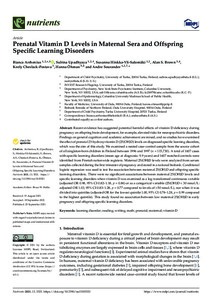Prenatal Vitamin D Levels in Maternal Sera and Offspring Specific Learning Disorders
Arrhenius Bianca; Upadhyaya Subina; Hinkka-Yli-Salomäki Susanna; Brown Alan S.; Cheslack-Postava Keely; Öhman Hanna; Sourander Andre
https://urn.fi/URN:NBN:fi-fe2021110554180
Tiivistelmä
Recent evidence has suggested potential harmful effects of vitamin D deficiency during
pregnancy on offspring brain development, for example, elevated risks for neuropsychiatric disorders.
Findings on general cognition and academic achievement are mixed, and no studies have examined
the effect of prenatal 25-hydroxyvitamin D (25(OH)D) levels on diagnosed specific learning disorders,
which was the aim of this study. We examined a nested case–control sample from the source cohort
of all singleton-born children in Finland between 1996 and 1997 (n = 115,730). A total of 1607 cases
with specific learning disorders (mean age at diagnosis: 9.9 years) and 1607 matched controls were
identified from Finnish nationwide registers. Maternal 25(OH)D levels were analyzed from serum
samples collected during the first trimester of pregnancy and stored in a national biobank. Conditional
logistic regression was used to test the association between maternal 25(OH)D and offspring specific
learning disorders. There were no significant associations between maternal 25(OH)D levels and
specific learning disorders when vitamin D was examined as a log-transformed continuous variable
(adjusted OR 0.98, 95% CI 0.82–1.18, p = 0.84) or as a categorical variable (25(OH)D < 30 nmol/L:
adjusted OR 1.03, 95% CI 0.83–1.28, p = 0.77 compared to levels of >50 nmol/L), nor when it was
divided into quintiles (adjusted OR for the lowest quintile 1.00, 95% CI 0.78–1.28, p = 0.99 compared
to the highest quintile). This study found no association between low maternal 25(OH)D in early
pregnancy and offspring specific learning disorders.
Kokoelmat
- Rinnakkaistallenteet [27094]
